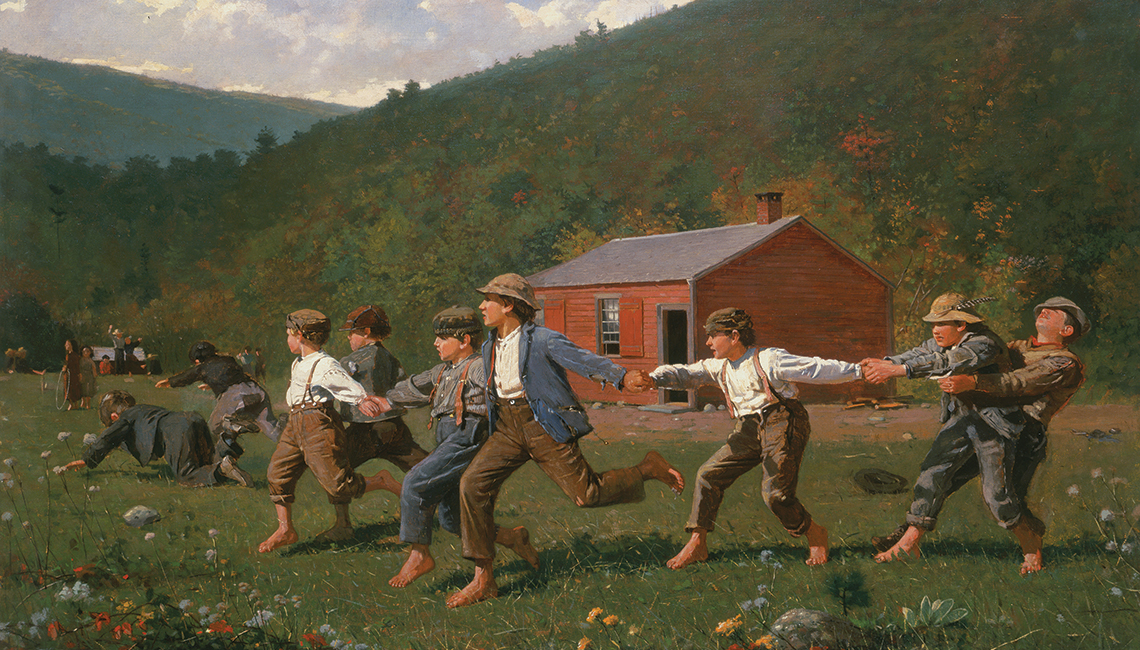Louis Zona breathed a sigh of relief a couple of months ago when Snap the Whip safely returned to the Butler Institute of American Art in Youngstown. Zona is the museum’s executive director, and last year’s worsening pandemic and riots concerned him because the priceless Winslow Homer painting was touring in a national show. “We don’t lend it often, and I worried for months,” he says.
Considered Homer’s best work, the 1872 painting depicts high-spirited schoolboys playing an outdoor game. The Butler’s founder, Youngstown industrialist and pioneering American art collector Joseph G. Butler, purchased it shortly before the museum’s 1919 opening. “Snap the Whip is among the country’s most significant paintings because it captures America’s energy and confidence after the Civil War,” says Zona. “Winslow Homer was to painting what Mark Twain was to literature.”
"Snap the Whip," by Winslow Homer, 1872 (oil on canvas).
The Butler was the first museum built solely for works by American artists, and for decades, Butler family members augmented its collection with masterpieces such as Albert Bierstadt’s The Oregon Trail and Edward Hopper’s Pennsylvania Coal Town. After Joseph G. Butler III died in 1981, Zona was appointed director. At the time, he chaired Youngstown State University’s art department, but his association with the museum began in the early 1970s. “My dissertation was about museum operations, and I used the Butler for my lab,” says Zona.
He also was a model for Americans: Youngstown, Ohio, the museum’s monumental painting by Alfred Leslie that chronicles the devasting impact of the “Black Monday” in 1977 when 5,000 Youngstown steelworkers lost their jobs. Zona helped recruit the grim-faced men and women who appear in the painting. “Alfred wanted people from different backgrounds and told us to dress like we were going to the movies,” he recalls.
In 1987, Zona expanded the museum to include a space to exhibit sports art. Today, the Donnell Gallery showcases the games America plays, with works ranging from End Run, John Steuart Curry’s evocative college football lithograph, to Pete Rose, Andy Warhol’s pop art print. The first of its kind in any museum, the Donnell Gallery also reflects Zona’s fervor for sports.
“Youngstown sits in a sports-crazy area that goes from eastern Ohio into western Pennsylvania, and I’m no different from everybody else,” says Zona. “I love baseball, and college football makes me crazy.”
Zona grew up 20 miles from Youngstown in New Castle, Pennsylvania, and his boyhood idol was Mickey Mantle. “If Mantle went 0 for 4, I couldn’t sleep,” he says. When the 1960 World Series pitted his beloved Pittsburgh Pirates against Mantle’s New York Yankees, Zona had to make a hard choice, but he admits, “I’m a Pirates fan forever.”
Both Mantle and Bill Mazeroski, whose home run clinched the series for the Pirates, are featured in the Donnell Gallery’s centerpiece painting, Baseball Album, by Gary Erbe. The Butler commissioned the piece, and its collage of items — including bats, gloves, and a Kellogg’s Corn Flakes box starring Ted Williams — convey the national pastime’s cultural impact.
Zona has stories to share about virtually every work in the gallery. Pausing at Davey Moore, an oil painting of the featherweight champion from Springfield, he says, “The artist is Audrey Flack, who told me her father took her to boxing matches.” At Gowanus Canal, Randy Dudley’s vision of Brooklyn ice skaters, he says, “This was a gift from a New York dealer, and it’s pure fantasy because the polluted canal never freezes.” At A Gentleman’s Sport, Gary Erbe’s golf canvas, Zona reveals he provided the vintage clubs that are part of the work. “Erbe was looking for old golf clubs,” he says, “and I still had my dad’s set.”
His inside-baseball comments speak volumes about the Butler’s status as an all-time-great American institution. “Any museum in the world that is doing a show on American art calls on us,” he declares. For 40 years, Zona has acted as the Butler’s manager, coach, quarterback, scout, trainer, and head cheerleader, and during his tenure, the museum has tripled in size and grown its collection to some 22,000 works by thousands of American artists.
“People sometimes ask why I’m not retired,” he says. “I tell them I love art, and I’m always happy when I’m here.”












